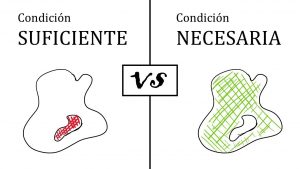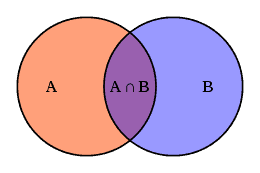Very good to all of you who come to read an explanation about the terms of Need and Sufficiency in mathematical language because you are as lost as I am these last two days.
Not long ago I started an Introduction to Mathematical Thinking course, online at the prestigious Stanford University, from the hand of the doctor in mathematics Keith J. Devlin, and to my surprise, as soon as I finished the introductory topic, I ran into a big wall: the conditions or relationships of implication between two statements or premises.
After many hours spent simplifying it to the extreme, I want to express my conclusions to help whoever needs it and, above all, to be able to resort to them every time I find myself lost solving this type of mathematical logical reasoning problems.
Post content:
Necessity (⇒) and Sufficiency (⇐) in Mathematics – Simple Explanation
The first paragraph of Wikipedia, translated into Spanish, reads like this:
In logic and mathematics, necessity and sufficiency are terms used to describe a conditional or implication relationship between two statements. For example, in the conditional statement "If N then S", S is necessary for N, because the truth of S is guaranteed by the truth of N (equivalently, it is impossible to have N without S). Similarly, N is sufficient for S, because N being true always implies that S is true, but N not being true does not always imply that S is not true.
And it is beginning to be seen that it is somewhat complicated to keep up with the explanation, and although the words alone briefly explain the functioning of these relationships or conditions of implication, they do not end up being precise when dealing with them in natural language, so we will start with the basics:

How does the Table of Truths work?
So that the Table of Truths result in a TRUE, it is required that the two conditions or premises have logical sense. This means that as long as there is a real case in which each of the premises exists, the result will be true, regardless of whether the premises themselves are true or false.
We can see it below with an example:
we will call Yes to "be dad«, and we will call N to "being a man«.
If we take into account the four possible combinations we obtain the following table:
| S – Being a father | N – Be a man | Result |
|---|---|---|
| You are a father | You are a man | It's possible (true) |
| You are a father | you are not a man | It's not possible (fake) |
| You are not a father | You are a man | It's possible (true) |
| You are not a father | you are not a man | It's possible (true) |
As you can see, these reasonings do not follow properly Boolean logic, which is what we are most accustomed to. In Boolean algebra, the combination of conditions alters the result directly, and here, on the other hand, it is not their combination per se that shapes the result, but rather their combination together with the given context.
In summary: the two conditions give a true result as long as they can be combined and produce a real example.
Now let's move on to something a little more complex: Are they premises with a relation of Need, of Sufficiency, either Bidirectional?
Need Ratio (S ⇒ N)
A Necessity relationship is always written with the notation "(S ⇒ N)", and interpreted in human language the sentences that best describe this relationship are:
- if S, then N → "if you are a father, then you are a man."
- S implies N → "being a father implies being a man."
- S only if N → "you are a father only if you are a man."
- N, if S → "you are a man, if you are a father."
- N whenever S → "you are a man as long as you are a father."
- N when S → "you are a man when you are also a father."
In this case, the second premise "being a man" is NECESSARY for the first condition "being a father" to be met. Thus, the relationship of necessity works in the opposite direction to that indicated by the arrow (at least taking into account Catidian use of arrows).
In this way, the table that we have seen previously is generated:
| S – Being a father | N – Be a man | Result (S ⇒ N) (Need Relationship) |
|---|---|---|
| Be dad | Being a man | It's possible (true) |
| Be dad | not be a man | It's not possible (fake) |
| Not being a father | Being a man | It's possible (true) |
| Not being a father | not be a man | It's possible (true) |
Where we see that if you are not a father, there is no need to be a man, so the result will always be true. On the other hand, if it happens that you are a father, it is mandatory that you be a man, otherwise the combination of both will not make logical sense. It is understood?
We are entering turbulent waters 🙂
In summary: To prove that a relationship implies necessity, it is essential to prove that it does not make sense for the first premise to be met without the second being met.. That's the only important detail in all of this. Once it has been proven that it is a relationship of necessity, it is also possible that it is a bidirectional relationship; Keep reading so that all this is clear to you ;p
In even greater summary: That the first premise is true, guarantees the truth of the second. If the second were false, there would be no logical sense.
Sufficiency Ratio (S ⇐ N)
A Sufficiency relation is always written with the notation "(S ⇐ N)", and some of the sentences that I think best describe this relation are:
- if not S, then not N → “if you don't have a degree, you're not a doctor.”
- no S implies no N → “not having a degree implies that you are not a doctor.”
- N only if S → "you are a doctor only if you have a career."
Returning to the explanation…
In this case, the fact that the first premise is met is ENOUGH to affirm that the result will be true, while if the first condition is not met, the result will depend on the second sentence and the logical sense they may have when combined.
In this way, taking the previous example, we cannot say that being a parent is enough to know that the result will be true (remember that the result is true only if the combination of both premises makes sense), since it could be the case that "being a father" and "not being a man", where the result will be false.
On the other hand, if the premises were: Yes = «have a career", and N = «be a doctor«, we could say that S (having a career), is enough for the result to be true (in other words: that there are real cases whatever the second premise).
| S – Have a university degree | N – Be a doctor | Result (S ⇐ N) (Sufficiency Ratio) |
|---|---|---|
| have a career | Be a doctor | It's possible (true) |
| have a career | Not being a doctor | It's possible (true) |
| Not having a career | Be a doctor | It's not possible (fake) |
| Not having a career | Not being a doctor | It's possible (true) |
Where we see that if you do not have a degree, you will not be able to say that you are a doctor, or otherwise, the combination of both premises would not make sense. On the other hand, if it happens that you do have a career, the second premise does not matter as much because the combination of both will always make logical sense. It is understood?
In summary: To prove that a relationship implies sufficiency, it is essential to demonstrate that if the first premise is not met, the second cannot be met.. That's the only important detail in all of this. Once it has been proven that it is a relationship of necessity, it is also possible that it is a bidirectional relationship; Keep reading so that all this is clear to you ;p
In even greater summary: The fact that the first premise is false guarantees the falsity of the second. If the second were true, there would be no logical sense.
Relationship of Need and Sufficiency (Bidirectional) (S ⇔ N)
A Necessity and Sufficiency relationship (or bidirectional relationship) is always written with the notation "(S ⇔ N)" or "(N ⇔ S)", and some of the sentences that I think best describe this relationship are:
- S is necessary for N, and N is necessary for S.
- Yes if N, and not Yes if not N.

Returning to the explanation…
In a bidirectional relationship, either of the two conditions is NECESSARY for the other to be met. In this way we can affirm that if condition S is met, N will also be met, and that if, on the other hand, S is not met, N should not be met either.
| S – It's August 5 | N – It's my birthday | Result (S ⇐ N) (Sufficiency Ratio) |
|---|---|---|
| It's August 5 | It's my birthday | It's possible (true) |
| It's August 5 | It is not my birthday | It's not possible (fake) |
| It's not August 5 | It's my birthday | It's not possible (fake) |
| It's not August 5 | It is not my birthday | It's possible (true) |
The simultaneous relationship of necessity and sufficiency for me is the clearest of the three, since if you show that the two premises need the same value (or the two positive, or the two negative), you can already affirm that it is a relationship bidirectional.
In other words, it is enough to demonstrate that the positive-negative and negative-positive premises do not have a logical sense.
I hope I have helped you a little if you were studying these philosophical and mathematical concepts and did not understand them. Remember that you can always leave a comment asking something related or with the purpose of helping other people who read that comment.
Additionally, there is a second post talking about the existence quantifiers, also closely related to this course and mathematics.
